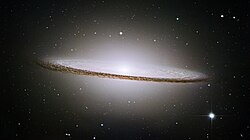Datei:Sombrero Galaxy in infrared light (Hubble Space Telescope and Spitzer Space Telescope).jpg

Größe dieser Vorschau: 800 × 448 Pixel. Weitere Auflösungen: 320 × 179 Pixel | 640 × 359 Pixel | 1.024 × 574 Pixel | 1.280 × 717 Pixel | 3.000 × 1.681 Pixel
Originaldatei (3.000 × 1.681 Pixel, Dateigröße: 3,98 MB, MIME-Typ: image/jpeg)
Dateiversionen
Klicke auf einen Zeitpunkt, um diese Version zu laden.
| Version vom | Vorschaubild | Maße | Benutzer | Kommentar | |
|---|---|---|---|---|---|
| aktuell | 22:46, 20. Jul. 2009 |  | 3.000 × 1.681 (3,98 MB) | Tryphon | {{Information |Description=NASA/ESA Hubble Space Telescope and NASA's Spitzer Space Telescope joined forces to create this striking composite image of one of the most popular sights in the universe. Messier 104 is commonly known as the Sombrero galaxy bec |
Dateiverwendung
Die folgende Seite verwendet diese Datei:
Globale Dateiverwendung
Die nachfolgenden anderen Wikis verwenden diese Datei:
- Verwendung auf ast.wikipedia.org
- Verwendung auf az.wikipedia.org
- Verwendung auf bs.wikipedia.org
- Verwendung auf cs.wikipedia.org
- Verwendung auf en.wikipedia.org
- Verwendung auf en.wikiquote.org
- Verwendung auf en.wikiversity.org
- Verwendung auf es.wikipedia.org
- Verwendung auf fa.wikipedia.org
- Verwendung auf frp.wikipedia.org
- Verwendung auf fr.wikipedia.org
- Verwendung auf he.wikipedia.org
- Verwendung auf id.wikipedia.org
- Verwendung auf it.wikibooks.org
- Verwendung auf kk.wikipedia.org
- Verwendung auf kn.wikipedia.org
- Verwendung auf mg.wikipedia.org
- Verwendung auf pl.wikipedia.org
- Verwendung auf pt.wikipedia.org
- Verwendung auf simple.wikipedia.org
- Verwendung auf sk.wikipedia.org
Weitere globale Verwendungen dieser Datei anschauen.


